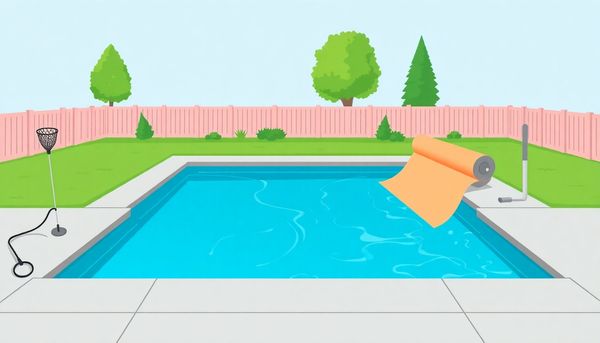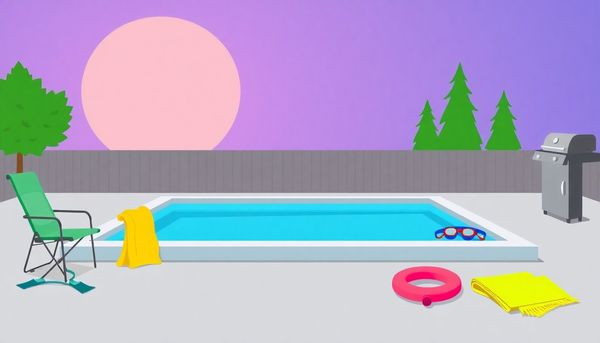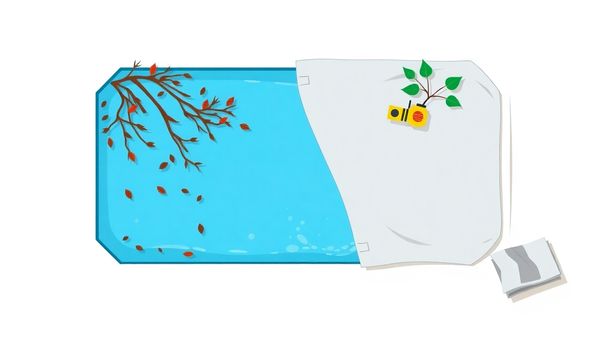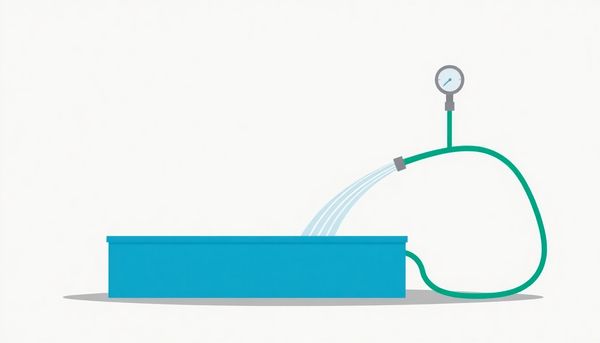Effortlessly Open Your Inground Pool for a Fun-Filled Summer
March 09th, 2024
March 09th, 2024
As the first warm rays of spring make their way through winter’s lingering chill, thoughts often turn to long, lazy days spent lounging by the pool. Opening an inground pool is a time-honored ritual that signals the start of summer fun. Having grown up with a backyard pool, I vividly remember the excitement of uncovering the sparkling water, a task that seemed magical as a child. As an adult, understanding the steps to properly open a pool can transform this chore into a seamless experience, setting the stage for months of enjoyment.
A well-prepared pool opening ensures not only a clean, safe swimming environment but also extends the life of your pool's equipment. Starting with a thorough inspection of your pool’s cover, you transition through essential tasks such as balancing the water’s chemistry and firing up the filtration system. Each step, from tidying up leaves to checking for leaks, is crucial. They aren't just tasks on a checklist; they are part of a holistic approach to pool care.
Diving into the process with strategic know-how can save both time and money. There’s an art to efficiently opening an inground pool, and as you follow along, you'll find that the 13 steps to success are not just about mechanics, but about ushering in a season filled with laughter, relaxation, and joy. Whether you're a novice or a seasoned pool owner, this guide promises to equip you with practical knowledge and tips for a splashing good start to summer.

The anticipation of dipping into a newly opened pool can be thrilling, yet the prospect of uncovering it might seem daunting. However, with the right approach and a touch of teamwork, this task transforms into a manageable step towards summer bliss. Start by gathering your tools—a soft broom, pool cover pump, and, crucially, safety gear. Protecting yourself is paramount, especially when dealing with chemicals that can cause harm with just a splash or a whiff.
Now, with a buddy by your side, carefully sweep the debris off your pool cover. Those pesky leaves and twigs have overstayed their welcome. Your pool cover pump will take on the standing water, but be patient; some pumps work more swiftly than others. As the water drains away, use this time to inspect your cover. Did it survive the winter unscathed? If not, it might be time to consider a replacement, saving you a cleaning session down the line.
With the cover now manageable, fold it systematically with your partner. This accordion technique ensures you keep it intact and makes the next steps smoother. Once folded, lay it flat away from the pool to clean it. Here, your soft broom and a gentle cleaning solution will do wonders in restoring it to its pre-winter glory. Remember, harsh chemicals can damage the cover, so stick to pool-safe products.
Finally, rinse and dry the cover thoroughly before storing it in a pest-proof container. This careful handling not only prolongs the life of your cover but also sets the stage for a seamless swimming season. As you store away your gear and tools, take a moment to appreciate the gleaming water. You’re just a few steps away from that refreshing dive, with safety and preparation as your trusted allies.
Standing poised with pool ambitions, the last thing anyone wants is a missing tool to derail the opening ceremony. As you contemplate the task ahead, gather your essential gear with precision. Begin with a trusty garden hose to refill what winter's chill may have evaporated. Next, secure a soft broom to whisk away the remnants of autumn leaves and debris clinging to your pool cover. No one wants to plunge into a season of swimming with unresolved murkiness lingering.
Safety first: don’t overlook protective eyewear and chemical-resistant gloves. Pool chemicals, though harmless to clear waters, can be perilous to unprotected skin and eyes. A friend once shrugged off these essentials, only to end up with a minor chemical burn – a cautionary tale worth heeding.
Another must-have is a pool cover pump, the unsung hero in preventing mini lagoons from forming atop your pool cover. Not all pumps are created equal; some are adept at both water and debris extraction, while others need a gentler touch. It’s worth knowing your pump’s capabilities to avoid unexpected frustration.
Finally, arm yourself with a reliable skimmer. As your pump hums along, this tool will gracefully glide over your pool's surface, capturing any residual debris that managed to escape your winter cover. With these tools in hand, your journey from poolside chaos to tranquil oasis begins with confidence.
Gazing at a neglected pool cover can be daunting, but transforming it into a spotless, stowed protector is a rewarding part of opening your pool. Begin by enlisting a friend; a second set of hands makes this task much more manageable. Carefully remove any large debris with a soft broom. It's crucial to avoid dragging the cover over rough surfaces which might tear it. Once cleared, place your pool cover on a flat, clean area such as your backyard lawn, where it can be easily cleaned without contaminating the pool water.
Once spread out, apply a gentle pool cover cleaner or a mild car wash soap. Use a soft brush to scrub away any grime or residue. Be sure to avoid abrasive tools that could damage the fabric of your cover. Rinse thoroughly, ensuring no soap remains, as residual cleaner could compromise the material if left to dry. The cover should be completely dry before folding it up to prevent mildew; a leaf blower can expedite this step.
Finally, store the cover in a large, sealable container or an appropriate storage bag. This prevents unwelcome guests like insects or rodents from making a summer home of it. Elevating the stored cover off the ground keeps moisture and pests at bay, thus preserving it for future use. By treating your pool cover with care now, you’re ensuring an easier pool closing when the chill of winter rolls around again.
As you prepare to return your pool to its summertime glory, the chemistry of your water is a crucial stage you can't overlook. After months of dormancy under a protective cover, your pool water may resemble more of a science experiment than a refreshing oasis. It’s time to channel your inner chemist without the lab coat, and tackle the task of priming and balancing your pool’s water chemistry.
Start by testing the water’s chemical levels with reliable test strips or, for precision, take a sample to your local pool store. This provides a clear picture of what imbalances need correcting. Focus first on the alkalinity, which acts as a buffer for pH fluctuations. Adjusting this ensures that your pH levels, the next priority, remain stable. High or low pH can cause irritation or damage to pool equipment, so getting this just right is crucial.
Calcium hardness comes next; too much can lead to scaling, while too little may corrode surfaces. Adjust as necessary to protect your pool’s integrity. For those pesky metals that may have sneaked in during winter, adding a sequestrant will prevent unsightly staining and buildup.
Now, with a balanced canvas, introduce pool shock to eliminate any lurking bacteria or algae spores. Remember, safety first: wear goggles and gloves while handling chemicals. Once the shock has had time to work its magic, you'll be rewarded with inviting, clear water, ready to welcome you back for the season.

Standing by your pool, surrounded by scrubbing tools and safety gear, you might wonder where to begin. Organizing your essential pool gear is like setting the stage for a successful dive into the new season. First, gather your pool-opening toolkit; a garden hose, pool cover pump, and skimmer net are just the beginning. These tools are your allies in transforming your pool from murky to magnificent.
Consider the safety factor. Pool chemicals can be hazardous and need careful handling. Protective gloves and goggles are not mere accessories; they’re your first line of defense against chemical mishaps. A friend of mine learned this the hard way after neglecting proper gear, resulting in a nasty chemical burn. Don’t overlook these essential items in your preparation.
Once safety is assured, think about efficiency. Having everything within arm's reach avoids those frustrating moments of searching for a tool right when you need it. Lay out your supplies on a portable table or poolside cart—keeping them organized and visible makes the task less daunting. This system not only saves time but also helps prevent accidental spills or mix-ups.
Finally, double-check your inventory. Whether it’s the right type of shock or a filter-cleaning brush, having the correct supplies ensures that no unexpected trips to the store halt your progress. With essentials at the ready, you’ll tackle the opening process with ease, setting you up for a summer of seamless swimming.
Opening an inground pool is an exciting ritual of welcoming the warmer months, but amidst the enthusiasm, safety must remain paramount. Handling pool chemicals without the right protective gear can transform a pleasurable task into a hazardous one. Thousands each year pay the price with unexpected trips to the emergency room due to accidental exposure to pool chemicals. Therefore, donning the correct protective attire is not merely advisable—it's essential.
A friend once disregarded safety goggles while mixing pool chemicals. Unfortunate contact resulted in irritation that lingered for days, a reminder of the importance of eye protection. Safety goggles shield against the splashes and fumes that can cause such discomfort, providing an extra layer of defense. Similarly, chemical-resistant gloves form a barrier between your skin and the harsh substances used in pool maintenance. Even a small splash can cause burns or irritation, making gloves indispensable.
Moreover, a dust mask can protect your respiratory system when handling powdered or granular chemicals, preventing inhalation of potentially harmful particles. It's easy to overlook this step when eager to get the pool ready, but taking a moment to equip yourself properly can prevent long-term health issues. Ultimately, investing in protective gear is a small price to pay for the peace of mind and safety it brings. As you prepare for a season of poolside relaxation, ensure that safety takes a front seat in your preparation process.
Tackling the grime on a pool cover after a long winter can feel like a daunting task, but with a few strategic steps, you’ll breeze through the process and have your pool ready in no time. First, gather the essentials: a soft broom, pool cover pump, and a reliable friend for some extra muscle. As you stand ready with your tools, start by gently sweeping off any large debris like leaves or twigs. This simple step prevents those bits from making their way into your pool as you remove the cover.
Next, employ your pool cover pump to eliminate any standing water. It’s worth knowing the capabilities of your pump—some models handle debris better than others. Once the water is gone, you and your friend can lift and fold the cover in an accordion style. This makes it easier to manage and transport without risking tears or wear.
Once the cover is off and laid out on a flat surface, it's cleaning time. Opt for pool cover cleaner or mild car wash soap. Use the broom to gently scrub away dirt, avoiding any harsh chemicals that could damage the material. After a thorough rinse, use a towel or leaf blower to dry the cover completely.
Store the cleaned cover in a sealed bag or container to keep pests away. A careful cleaning and storage routine not only prolongs the life of your pool cover but also makes next season's opening a breeze.
Standing by the edge of a newly opened pool, the anticipation of a refreshing dip is only overshadowed by the importance of ensuring the water is crystal clear. Water clarity hinges on properly balanced chemistry, an often underestimated part of pool maintenance. Understanding your pool’s unique chemical needs begins with a thorough water test. Whether you’re using test strips or taking a sample to your local pool store, this step is crucial for identifying what adjustments are necessary.
Once you’ve pinpointed the imbalances, start with alkalinity. Adjusting it first helps stabilize pH levels, which in turn affects the effectiveness of your chlorine. A pH that’s too low or too high not only irritates swimmers but can also damage pool equipment. After achieving the right pH, turn your attention to calcium hardness, which prevents corrosion and scaling.
With the basics balanced, consider the role of clarifiers and flocculants. While clarifiers help clump fine particles together for easier filtration, flocculants are particularly useful for dropping larger debris to the pool floor, simplifying vacuuming. My neighbor once struggled with chronic cloudiness until he discovered the transformative power of a quality flocculant, which quickly turned his murky lagoon into a sparkling oasis.
Finally, don’t forget routine maintenance. Regularly test and adjust your water chemistry to maintain that clear, inviting waterscape throughout the summer. This diligence not only enhances your swimming experience but prolongs the life of your pool, making every swim a pleasure rather than a chore.

The arrival of pool season promises the joy of sunlit swims, but first, there’s the small matter of that tired, weathered pool cover to deal with. It's easy to procrastinate when faced with a cover layered in leaves and who-knows-what from months of dormancy. Yet, this essential step is a lot more straightforward with a bit of strategy and teamwork.
To start, gather your cleaning tools: a soft broom, a pool cover pump, and a reliable cleaner. Get a buddy to help you lift the cover gently off the pool, ensuring you don't drag it over abrasive surfaces that could cause tears. Folding it accordion-style with a partner makes the process smoother and keeps your pool edge tidy. Once removed, find a flat surface to lay it out for a thorough clean.
Apply a pool cover cleaner or a mild car wash soap, and use the broom to scrub gently. Abrasive brushes can damage the material, so a soft touch is key. After scrubbing, rinse the cover thoroughly and let it dry using a leaf blower or towel. Make sure it's completely dry before folding it for storage to prevent mold or mildew growth. Place it in a sturdy container with a lid to keep it pest-free until next season.
By dedicating a little time to cleaning your pool cover now, you ensure the longevity of your investment while paving the way for a sparkling swimming season. With this task behind you, you're one step closer to diving into those refreshing waters.
Standing by your pool in anticipation of the season's first dive, it's easy to overlook the importance of protective gear. Yet, safeguarding yourself with the right equipment is crucial. Handling pool chemicals without protection is like trying to cook without oven mitts—eventually, you’re going to get burned. Many seasoned pool owners can recount tales of minor mishaps that could have been prevented with just a pair of gloves or goggles.
Every year, emergency rooms see a spike in visits due to chemical irritations and respiratory issues caused by improper handling of pool supplies. Ensuring you have chemical-resistant gloves, safety goggles, and a face mask on hand isn't just a recommendation—it's a necessity. These items act as barriers, shielding your skin and eyes from harsh substances, and filtering out any noxious fumes that might arise as you prepare your pool for the summer.
Beyond personal protection, this gear helps prevent accidents that could delay your pool opening. Consider it an investment in peace of mind. Whether it's lifting the pool cover or adding shock to the water, the right gear lets you tackle each task confidently. So, as you gather your essentials for pool opening day, let protective gear top your list. It's a small step with a big payoff, ensuring you enjoy a safe and enjoyable swimming season ahead.
Tackling the mess atop your pool cover is the first step in reclaiming your backyard oasis. Armed with a soft broom and a reliable pool cover pump, you'll find yourself more than equipped to face the challenge. Start by sweeping away any leaves and twigs that have made your pool cover their temporary home during the colder months. This not only lightens the load on your pump but also prevents clogs that could slow down the process.
Next, place your pool cover pump strategically to suck up any standing water. It's fascinating how some pumps are engineered to handle even the smallest puddles, turning what might seem like an overwhelming task into something manageable. However, understanding your pump's capabilities is vital to avoid overstraining it. If you have a model with iSwitch technology, it will automatically activate when it detects water, making your job even easier.
Once the cover is debris-free and waterless, team up with a friend to fold it carefully, avoiding any rough patches that might damage it. This is also the perfect time to inspect for any tears or damages. Spreading the cover out in your yard for a thorough cleaning is essential. Use pool cover cleaner or mild car wash soap and gently scrub with a soft broom. Rinse thoroughly, let it dry, and store the cover in a pest-proof container for the season. This way, when it's time to close your pool again, you’ll have a clean, intact cover ready to protect your pool through the winter months.
As the sun begins to warm up your backyard, removing and storing your pool cover becomes the first step towards a refreshing swim. While it might seem like a chore, it's an essential task in maintaining your pool for the season. First, ensure you've got your trusty garden hose and pool cover pump at the ready. These tools will help you efficiently clear away any accumulated water and debris.
Enlist the help of a friend to make this job easier and more efficient. Together, gently lift and fold the cover, being cautious not to drag it over rough surfaces that might cause tears. Once removed, spread it out on a flat surface like your lawn or a clean driveway. This space will allow you to clean the cover effectively without introducing grime into your pool.
With your pool cover laid out, apply a suitable cleaner or even mild car wash soap, using a soft broom to scrub away dirt and stains. It's crucial to avoid harsh chemicals or abrasive tools that could damage the material. After scrubbing, rinse thoroughly to wash away all soap residues. A leaf blower or towel can then be used to dry the cover.
Finally, fold the clean, dry cover carefully and store it in a sealed container, away from pests and moisture. This thoughtful storage method prevents unpleasant surprises when it's time to use it again. As you head back to your pool, take a moment to appreciate this effort—it’s the first splash towards a fun-filled pool season.

Water levels in your pool are like the heartbeat of the aquatic oasis in your backyard. Over a long winter, evaporation and maintenance can leave your pool looking a little shallow. The first step in getting ready for a new pool season is to bring those water levels back up to their prime. This doesn't just ensure you have enough water to swim in, but it also helps balance your pool chemistry more effectively right from the start.
Start by giving your garden hose a starring role in this process. Attach a hose filter to avoid any unwanted metals or debris from hitching a ride into your pool. This filter acts as a first line of defense, preventing metals like iron and manganese from becoming surprise guests at your pool party. Adding water before balancing chemicals saves you from doubling your work, steering clear of having to recalibrate your pool's chemistry later.
While filling, keep an eye on the water’s pace—too fast and you risk overfilling before you know it. A slow and steady flow is often best for maintaining control and preventing mishaps. As you watch the water rise, take a moment to enjoy the subtle ripple of anticipation, knowing that each drop brings you closer to that first refreshing dive. Once the water reaches the midpoint of your skimmer, you’re ready to move on to the next steps with confidence.
A sunny morning greets you as you prepare to tackle the annual rite of opening your pool. The anticipation of a refreshing swim is enough to get you moving, but first, there's work to be done. Gather your tools and essentials, and ensure they’re within arm’s reach. A garden hose, a pool cover pump, and a soft broom are just the start. Don’t forget something protective for your hands and eyes—those pool chemicals can be tricky, and safety always comes first.
Before you unearth the pool itself, focus on the cover. It's been through a lot this past winter, collecting leaves and debris. Use the broom to sweep it clean, and the pump to drain any standing water. This step is crucial; it prevents all that gunk from slipping into your pool the moment the cover comes off. Having a friend around makes the job easier—they can help you fold the cover neatly, preventing any tears from rough surfaces.
A thorough inspection of the pool cover is next. Spot any damage? Consider replacing it now rather than when you close the pool later. If it’s in good shape, give it a scrub with a gentle cleaner, rinse, and dry thoroughly. Store it in a pest-proof container to keep it safe until autumn rolls around. With this done, the pool is one step closer to sparkling under the sun once again.
Winter's embrace often leaves behind a collection of unwelcome remnants. As the frost retreats, it's time to tackle these lingering traces before your pool is ready for action. A close friend once shared her strategy, which transformed a daunting task into a manageable and even enjoyable routine. Armed with a broom and some determination, start by gently sweeping away leaves and twigs that have settled on your pool cover. It's incredible how much debris winter can bestow, like an uninvited guest overstaying its welcome.
Next, enlist the help of your trusty pool cover pump to remove any water that's been pooling up during winter rains and snow. Pumps vary in power, so it's worth knowing yours inside out—some might require a bit of patience, while others will zip through the task in no time. I remember discovering this firsthand when my pump decided to take its sweet time one spring morning. It taught me the virtue of letting technology do its thing while I savored a cup of coffee on the patio.
With the cover clear of water and debris, it's time for a team effort. Recruit a friend to help you carefully fold the cover. Avoid dragging it across rough surfaces, which could lead to tears. Once folded, set it down on a clean, flat area for a thorough wash. Use a gentle pool cover cleaner or car wash soap, along with a soft broom, to scrub away any remaining residue. After a good rinse and drying, store the cover properly to ensure it’s ready to protect your pool again come autumn. This small investment of time now means fewer surprises next season.
Finding the right balance in your pool's water chemistry can feel like a science experiment gone awry. Yet, it’s a crucial step to ensure crystal clear waters all summer long. After all, no one wants to dive into a pool that resembles murky swamp water. So, let’s get that water sparkling.
First, dust off those trusty test strips or take a sample to your local pool store. They'll help you decipher what your water is trying to tell you. In our pool-owning adventures, we’ve learned that starting with alkalinity sets the foundation. It’s akin to laying the concrete before building a house. Once alkalinity is stable, pH levels are next. Ideal pH ensures swimmers aren't hopping out with irritated eyes or dry skin. Lastly, calcium hardness rounds out this trio, keeping surfaces smooth and equipment in tip-top shape.
Simplifying this process, consider purchasing a start-up chemical kit. These contain all the essentials without the hassle of piecemealing individual components. Avoid the temptation to toss in unnecessary chemicals—less is often more when it comes to pool maintenance.
Don’t forget the safety angle. When adding chemicals, arm yourself with safety goggles and gloves. The importance of protective gear can’t be overstated; trust us, chemical mishaps in the backyard aren’t how anyone wants to spend a weekend. Once balanced, your pool will not only be a refreshing oasis but also a testament to your savvy pool-owner skills.

Let's talk about the unsung hero of pool season: your equipment. Before jumping into the refreshing waters, you need to ensure your pool's heart is beating smoothly. This means priming your pool equipment for action.
Start with your pump and filter system. These components are the workhorses that keep your pool sparkling clean. First, check if the drain plugs in your pump and filter are securely in place—using thread seal tape can help prevent leaks. O-rings, those rubbery rings that seal out air and water, need some attention too. Apply a generous layer of pool gasket lubricant to keep them supple and effective. If you spot any cracks or wear, replace them to avoid any unwanted air entering the system.
Now, it’s time to allow water back into your filtration system. Open your return-side valves, ensuring water can flow freely. For those with a multiport valve, set it to "waste" and reattach the air bleeder, sight glass, and pressure gauge. Fill up your pump filter basket with water to make priming easier. Once everything is ready, flip the switch at the circuit breaker and start your pump. Watch carefully as the water begins to flow through—this means your pump is successfully primed.
Lastly, keep an eye on your filter’s pressure gauge. A sudden spike is a signal to turn off your pump and check for blockages. Sometimes, a quick re-priming might be necessary. By taking these steps, you'll safeguard your equipment and ensure a delightful pool season.
As the sun reclaims its throne in the sky, the thought of reopening your inground pool becomes a tantalizing prospect. However, before you can plunge back into aquatic bliss, assembling the right tools is crucial. Start by gathering protective gear such as goggles and gloves. These aren't just for show—handling pool chemicals without them can lead to serious mishaps.
Next, check your inventory for essential cleaning tools. You’ll need a soft broom to gently remove accumulated debris from your pool cover. A reliable pool cover pump is also vital to efficiently drain any stagnant water.
Don't forget the standard pool maintenance items. A skimmer is essential for the initial sweep of leaves and large debris. It's best to keep a garden hose handy for rinsing down surfaces and refilling the pool after winter evaporation. If you haven't yet invested in one, consider a hose filter to keep out metals and impurities during refill.
For the more technical side of things, ensure you have pool chemicals like shock and algaecide, as well as a water test kit to determine what’s necessary for balancing. Thread seal tape and pool gasket lubricant safeguard your gear and prevent leaks when reinstalling plugs and O-rings.
Once you have your toolkit assembled, you'll be equipped to tackle the job with confidence. With these essentials at your fingertips, transforming your pool from a murky hibernation state into a summer oasis is just a matter of time and teamwork.

This article provided insights into maintaining your pool. Start your pool care journey today!
Want to become a pool maintenance expert? Our free Pool School course covers everything you need to know about pool care. From basic maintenance to advanced troubleshooting, you'll learn how to:
Join over 10,000 pool owners who have already transformed their pool care routine. Get started with our free Pool School course today!